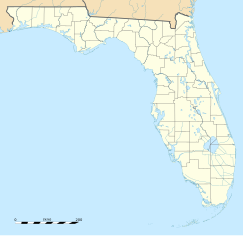Villa Vizcaya
| Villa Vizcaya | ||
|---|---|---|
| National Register of Historic Places | ||
| Historic District | ||
| National Historic Landmark | ||
|
Villa Vizcaya from the water |
||
|
|
||
| location | Coconut Grove , Miami-Dade County , Florida | |
| Coordinates | 25 ° 44 '39.4 " N , 80 ° 12' 37.8" W | |
| Built | 1914-16 | |
| architect | F. Burrall Hoffman Jr. | |
| Architectural style | Renaissance | |
| NRHP number | 70000181 | |
| The NRHP added | 29th September 1970 | |
| Declared as an NHL | April 19, 1994 | |
The Villa Vizcaya is a castle-like building in the style of a northern Italian villa of the Renaissance . It stands in Coconut Grove , Florida and was built in 1914-16 as a winter residence for the industrialist James Deering (1859-1925), the son of William Deering .
history

The main house, completed in 1916, was initially built on the originally 72.8 hectare site according to plans by the architect F. Burrall Hoffman junior , while Deering consulted the artist Paul Chalfin for the interior furnishings with numerous antiques . With its double axis of symmetry, the floor plan is based on Andrea Palladio and is centered around a glass-covered patio , which is made up of four corner pavilions and connecting wings with porticos . The property has 70 lounges and bedrooms, which are decorated with European furniture in different styles, e.g. B. in the Empire style .
The name Vizcaya originally comes from Basque and means “sublime place”. The design of the gardens dragged on until the 1920s. The garden architect Diego Suarez was responsible for them.
Villa Vizcaya was Deering's winter residence, who lived in it from 1916 until his death in 1925. In 1945 his heirs donated part of the gardens to the diocese of St. Augustine (Florida) and to a hospital. The main building was sold to Miami-Dade County and has been open to the public as the Dade County Art Museum since 1953. Vizcaya Museum and Gardens now covers 20 hectares in total. It was here that Ronald Reagan and Pope John Paul II met in September 1987. The Villa Vizcaya also served as a location for numerous films.
On September 29, 1970, Villa Vizcaya was entered as a Historic District on the National Register of Historic Places . Villa Vizcaya has been a National Historic Landmark since April 19, 1994 . By hurricanes Katrina and Wilma garden and cellar of the villa have been damaged.
gallery
literature
- James T. Maher: Twilight of Splendor: Chronicles of the Age of American Palaces. Little, Brown, Boston 1975, ISBN 0-316-54385-3 .
- Witold Rybczynski, Laurie Olin, Steven Brooke (photo): Vizcaya: An American Villa and Its Makers. University of Pennsylvania Press, Philadelphia 2006, ISBN 0-8122-3951-2 .
- Laurie Ossman (text), Bill Sumner (photos): Visions of Vizcaya . Vizcaya Museum and Gardens / Miami-Dade County, Miami 2006, ISBN 0-9779744-0-5 .
- Kathryn C. Harwood: Lives of Vizcaya . Banyan Books, Miami 1985, ISBN 0-916224-99-6 .
- Mac Griswold, Eleanor Weller: The Golden Age of American Gardens, proud owners-private estates 1890–1940 . Harry N. Abrahms, NY 1991, ISBN 0-8109-2737-3 .
Web links
Individual evidence
- ^ Vizcaya in the National Register Information System. National Park Service , accessed August 8, 2017.
- ↑ Listing of National Historic Landmarks by State: Florida. National Park Service , accessed July 20, 2019.




